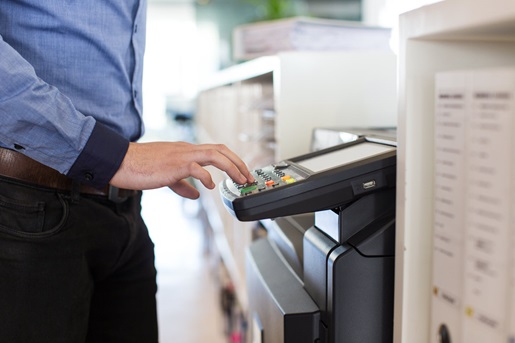Ensure printed data is secure and compliant
The healthcare industry has seen a digital acceleration over the past decade. Despite this, healthcare organizations continue to rely on printed documents to function. One study reports that the average hospital prints 96 million pages per year. Healthcare printers that can meet the daily demands of the modern hospital or practice are in demand.
Yet, healthcare organizations have unique security and privacy requirements. Their choice of healthcare printers must also meet these standards. Remember the following features and considerations when choosing a printer for your organization.
Looking for a printer to meet your industry’s unique needs? Check out our guide, Business Printing Solutions: Which Printer Fits Your Industry? for more information.
HIPAA, cyberattacks, and the importance of printer security
Healthcare organizations handle a wide variety of protected health information (PHI). This information includes insurance policies, medical history, prescriptions, and even names and addresses. Healthcare organizations must secure this data.
The Health Insurance Portability and Accountability Act (HIPAA) manages these requirements in the United States. Regulated entities that come into contact with PHI must safeguard this information to be compliant. These guidelines are set forth by the Privacy Rule and the Security Rule. These rules ensure that physical and electronic PHI remains secure. They also ensure that data remains accessible to authorized parties, and only those parties.
Ensuring PHI remains private within an organization is important enough on its own. Yet, keeping it secure is paramount to ensuring that it stays out of the hands of cyber attackers. According to The HIPAA Journal, attacks against healthcare organizations have increased in recent years. Cyberattackers stole more than 130 million records across 725 reported breaches within 2023. Malicious actors look for gaps in data security to steal PHI. Attackers can then use this data to commit further crimes. Ensuing incidents can include identity theft or Medicare fraud.
Healthcare IT administrators must take all network access points into consideration. Printers seem like innocuous equipment. Yet, their networking connectivity options can pose a significant security risk if mismanaged.
Did You Know?:The RICOH C125 MF keeps data secure with AES 128-bit encryption. Plus, its Locked Print function ensures sensitive documents aren’t left unattended.
Crucial security features for healthcare printers
Healthcare organizations place great importance on data security. Choosing a printer that reinforces this stance is vital. Look for the following features to help round out your HIPAA compliance processes:
- User access management. HIPAA-compliant printers may include the ability to set access passcodes. These passcodes prevent unauthorized users from printing documents such as PHI. Many printers also have a locked print function. This ensures that prints only start when someone enters their passcode into the printer they want to use. That way, you’ll reduce the chances someone leaves sensitive information unattended.
- AES 128-bit encryption. Data encryption is a crucial aspect of data security. It makes it harder for malicious actors to access information as it is transmitted to your printer. Look for printers that offer AES 128-bit encryption to maximize security.
Other essential features
Security should be near the top of your healthcare organization's priority list. Even so, treating patients efficiently and effectively remains the number one priority. As such, there are other features to consider when choosing healthcare printers. The following will help your organization keep operations running smoothly:
- Simple maintenance. Running out of paper and ink can take precious time out of your workday. This impacts patient schedules and provider workflows. Look for printers that offer easy access to paper trays and ink or toner cartridges so you can start printing again in minutes.
- Multi-functionality. Space is at a premium, even at the doctor’s office. Combining printing, scanning, copying, and faxing into a single device saves space. Plus, all-in-one printers reduce the number of trips employees need to make to complete crucial tasks.
- High-quality prints. Avoid communication breakdown by ensuring printed text is legible. Printers with at least 300 dots per inch (dpi) offer clear text reproduction at average reading distances.
Did You Know?:Ricoh offers next-business-day replacement for equipment that cannot be repaired through technical support. Learn about how our Advance Exchange Service Program can cut operational downtime.
Our recommendation: RICOH Printer C125 MF
In our opinion, only one choice offers supreme print quality, reliable operation, and versatility with the security features you need to maximize compliance: the RICOH C125 MF Color 4-in-1 Printer.
Rapid print speeds of up to 26 color pages per minute and multi-function capabilities provide patients with faster visits and a better quality of care. With robust user access management controls and AES 128-bit encryption, patient data remains secure. Click here to learn more or shop the rest of our printer line.
Note: Information and external links are provided for your convenience and for educational purposes only, and shall not be construed, or relied upon, as legal or financial advice. PFU America, Inc. makes no representations about the contents, features, or specifications on such third-party sites, software, and/or offerings (collectively “Third-Party Offerings”) and shall not be responsible for any loss or damage that may arise from your use of such Third-Party Offerings. Please consult with a licensed professional regarding your specific situation as regulations may be subject to change.






